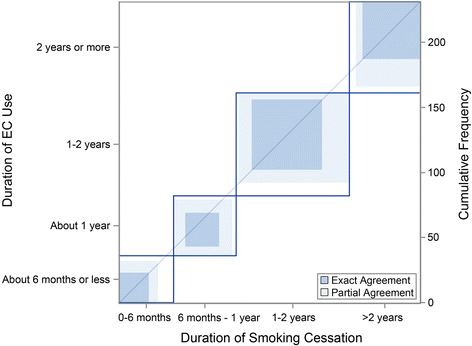Electronic cigarette use behaviors and motivations among smokers and non-smokers
- PMID: 28882123
- PMCID: PMC5590123
- DOI: 10.1186/s12889-017-4671-3
Electronic cigarette use behaviors and motivations among smokers and non-smokers
Erratum in
-
Correction to: electronic cigarette use behaviors and motivations among smokers and non-smokers.BMC Public Health. 2018 Jan 24;18(1):175. doi: 10.1186/s12889-018-5048-y. BMC Public Health. 2018. PMID: 29368600 Free PMC article.
Abstract
Background: The use of electronic cigarettes (EC) has risen exponentially over the past decade, including among never smokers, and ECs are now the most popular tobacco product among teenagers in the US. While, EC manufacturers utilize numerous marketing strategies to target both smokers and non-smokers, it is unclear how perceptions and behaviors differ between these two groups.
Methods: We conducted a survey of 320 adults either via online surveys or in Baltimore vape shops to determine demographics, behaviors, perceptions, and motivations underlying use of ECs.
Results: Our survey respondents were predominantly young, Caucasian males, 74% of whom identified themselves as former smokers, while 20% identified as current smokers and 6% were never smokers. Former smokers reported a longer history of EC use and higher nicotine concentrations than current smokers. For former and current smokers, the primary motivation for EC use was assistance to quit smoking, and nearly half indicated that they plan to reduce their nicotine concentration and eventually quit using ECs. Among former smokers, self-reports on use and measures of dependence were consistent with nicotine replacement as their primary motivation. The majority of former and current smokers also reported that their respiratory health had improved as a result of EC use, although this effect was stronger for former smokers. Never smokers reported less frequent EC use and dependence compared to former and current smokers. Their motivations for use were more commonly for enjoyment and popularity, and they displayed a reduced desire to eventually quit using ECs.
Conclusions: These responses provide insight into the underlying thoughts and behaviors of smoking and non-smoking EC users and also suggest that never smoking EC users are an emerging demographic with different motivations and perceptions than those of current and former smokers.
Keywords: Baltimore; Electronic cigarettes; Maryland; Preferences; Smokers; Survey; Vapor.
Conflict of interest statement
Ethics approval and consent to participate
This study was approved by the Institutional Review Board of the Johns Hopkins University. Oral consent was provided by both the store owner/manager and survey participant.
Consent for publication
The views expressed in this publication are those of the authors and do not necessarily reflect the official policy of the Department of Defense, Department of the Army, U.S. Army Medical Department or the U.S.
Competing interests
The authors declare that they have no competing interests.
Publisher’s Note
Springer Nature remains neutral with regard to jurisdictional claims in published maps and institutional affiliations.
Figures

Similar articles
-
Advice From Former-Smoking E-Cigarette Users to Current Smokers on How to Use E-Cigarettes as Part of an Attempt to Quit Smoking.Nicotine Tob Res. 2018 Jul 9;20(8):977-984. doi: 10.1093/ntr/ntx176. Nicotine Tob Res. 2018. PMID: 29065208
-
Indicators of cigarette smoking dependence and relapse in former smokers who vape compared with those who do not: findings from the 2016 International Tobacco Control Four Country Smoking and Vaping Survey.Addiction. 2019 Oct;114 Suppl 1(Suppl 1):49-60. doi: 10.1111/add.14722. Epub 2019 Aug 15. Addiction. 2019. PMID: 31225672 Free PMC article.
-
Delay discounting and e-cigarette use: An investigation in current, former, and never cigarette smokers.Drug Alcohol Depend. 2018 Oct 1;191:165-173. doi: 10.1016/j.drugalcdep.2018.06.034. Epub 2018 Aug 11. Drug Alcohol Depend. 2018. PMID: 30121475 Free PMC article.
-
A typology of vaping: Identifying differing beliefs, motivations for use, identity and political interest amongst e-cigarette users.Int J Drug Policy. 2017 Oct;48:81-90. doi: 10.1016/j.drugpo.2017.07.011. Epub 2017 Aug 12. Int J Drug Policy. 2017. PMID: 28810158
-
Perceptions of e-cigarettes: a comparison of adult smokers and non-smokers in a Mechanical Turk sample.Am J Drug Alcohol Abuse. 2017 May;43(3):311-323. doi: 10.1080/00952990.2016.1207654. Epub 2016 Aug 11. Am J Drug Alcohol Abuse. 2017. PMID: 27712126
Cited by
-
Welsh Primary Schoolchildren's Perceptions of Electronic Cigarettes: A Mixed Methods Study.Int J Environ Res Public Health. 2020 May 21;17(10):3639. doi: 10.3390/ijerph17103639. Int J Environ Res Public Health. 2020. PMID: 32455786 Free PMC article.
-
E-Cigarette Use in Young Adult Never Cigarette Smokers with Disabilities: Results from the Behavioral Risk Factor Surveillance System Survey.Int J Environ Res Public Health. 2021 May 20;18(10):5476. doi: 10.3390/ijerph18105476. Int J Environ Res Public Health. 2021. PMID: 34065407 Free PMC article.
-
Early Cardiovascular Risk in E-cigarette Users: the Potential Role of Metals.Curr Environ Health Rep. 2020 Dec;7(4):353-361. doi: 10.1007/s40572-020-00297-y. Epub 2020 Nov 26. Curr Environ Health Rep. 2020. PMID: 33242201 Free PMC article. Review.
-
Sensory experiences and cues among E-cigarette users.Harm Reduct J. 2020 Oct 15;17(1):75. doi: 10.1186/s12954-020-00420-0. Harm Reduct J. 2020. PMID: 33059666 Free PMC article.
-
Electronic cigarette use is negatively associated with body mass index: An observational study of electronic medical records.Obes Sci Pract. 2020 Dec 22;7(2):226-231. doi: 10.1002/osp4.468. eCollection 2021 Apr. Obes Sci Pract. 2020. PMID: 33841892 Free PMC article.
References
-
- American Industrial Hygiene Association. White paper: electronic cigarettes in the indoor environment. American Industrial Hygiene Association; Falls Church, VA; 2014.
-
- Vapour Products in the US. Euromonitor International 2016.
-
- US E-Cigarette and Vaporizer Market - Analysis, Estimation & Forecast (2015-2025). Research and Markets; 2015.
-
- Singh T, Arrazola R, Corey C, Husten C, Neff L, Homa D, King B. Tobacco Use Among Middle and High School Students — United States, 2011–2015. In: Morbidity and Mortality Weekly Report (MMWR). Centers for Disease Control and Prevention (CDC). 2016;65:361–7. - PubMed
MeSH terms
Grants and funding
LinkOut - more resources
Full Text Sources
Other Literature Sources
Medical
Miscellaneous

